Anyone who works in a public school knows that the teaching profession is at a crisis point. Things are a little better than they were a few years ago, as the world rebounds from a global pandemic. But 2025 teacher shortage statistics show things just aren’t getting better fast enough, and recent moves by the current federal administration have caused teacher job satisfaction and confidence to plummet. The years ahead will be critical for the American education system. Take a look at these numbers, and you’ll see what we mean.
Teacher Shortage Statistics FAQs

FREE PRINTABLE POSTER
How To Become a Teacher
Want to help end the teacher shortage? Share this How To Become a Teacher poster with your students to inspire the next generation of educators!
Does the United States have a shortage of teachers?
1. Nearly 3 out of 4 US school districts struggle to hire qualified educators.

A whopping 74% of districts had trouble filling their open positions for the 2024-25 school year. Special ed, science, and foreign language positions are the most likely to go unfilled, and in high-poverty areas, the numbers are even worse.
Source: National Center for Education Statistics School Pulse Panel
2. Around 50% of educators say their school is understaffed, leading to a heavier workload.

Teacher shortages are a problem, and teachers aren’t the only ones leaving education. Custodians, paraprofessionals, and cafeteria workers are also leaving schools, and teachers are picking up the slack in trying to make up for these lost staff members. When buildings are understaffed, educators often aren’t able to do the job they’ve been hired to do.
Source: National Center for Education Statistics School Pulse Panel
3. Nearly 60% of schools have trouble finding substitute teachers.
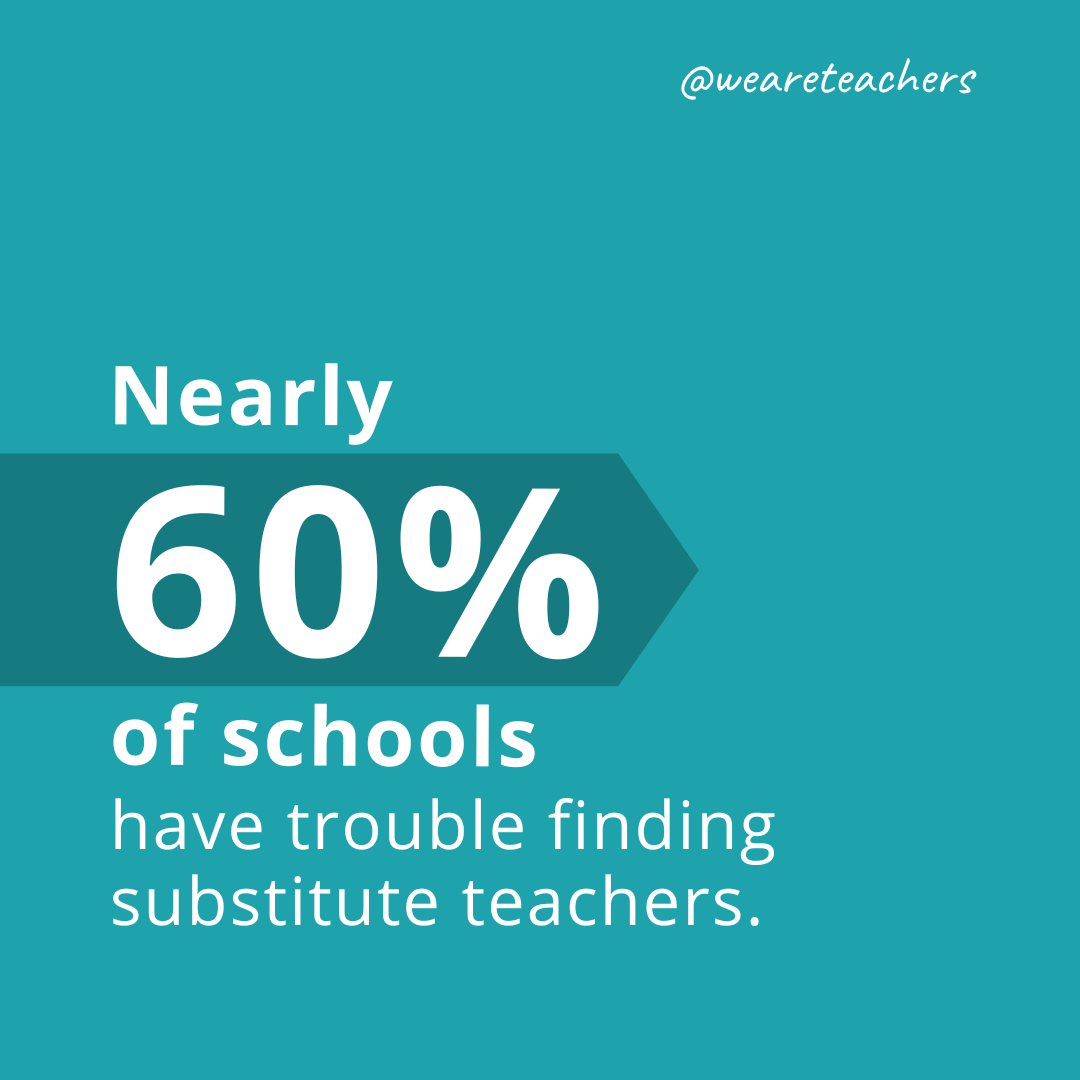
Teachers desperately need to be able to take time off when they’re sick; the cold/flu/COVID season is so much worse than it used to be. But many teachers are hesitant to call in, knowing that their school might not be able to find qualified coverage, leading students to fall behind. And with more than a quarter of schools concerned with teacher absences, this substitute teacher shortage is a serious problem in many places.
Source: School Pulse Panel: Absenteeism March 2024
4. Almost one-third (31%) of public schools reported that staff vacancies created the need to use non-teaching staff outside of their intended duties.
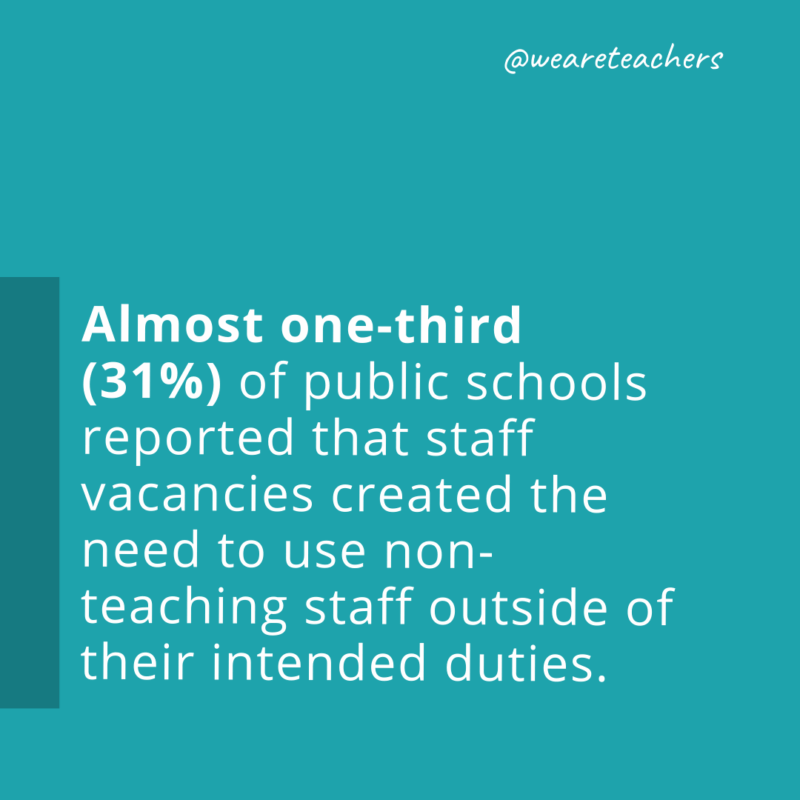
Administrative assistants and secretaries stepping in to cover classes, principals pulling bus duty … it’s OK when this happens once in awhile, but when these staff members are regularly pulled away from the jobs they were hired for, those jobs go undone. School staff are always willing to do what’s needed to benefit students in the moment, but that doesn’t always benefit the schools in the long run.
Source: National Center for Education Statistics School Pulse Panel
5. More than 1 in 5 schools (21%) say that teacher shortages have caused increased class sizes.

Any teacher will tell you: Smaller class sizes are better. They allow for more focused attention on individual students, increased educational resources for all, and lower stress for teachers. But the lack of teachers in the United States has caused many schools to bump up the number of students in each class. In high-shortage states like Utah, where the teacher-student ratio is 1:23 (compared to a national average of 1:16), this is one of the biggest impacts of vacant teacher positions.
Source: National Center for Education Statistics School Pulse Panel
6. About 18% of teachers say they definitely won’t or might not return to the classroom next year.
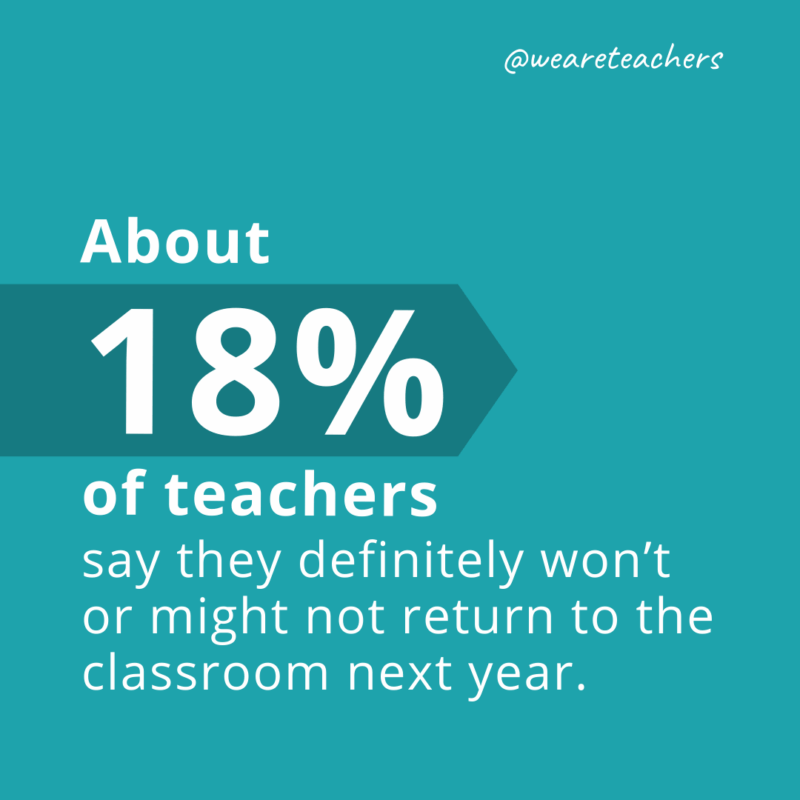
And that number jumps to 30% for teachers of color. Why are so many teachers who previously considered themselves career educators leaving? It could be the lack of support, the constant work, and struggles with student behavior issues. When schools and districts are losing educators, they need to be reflective in order to make a change and retain the people who will make an impact on their students.
Source: Teaching for Tomorrow: Educators on the Future of Their Profession
Which states have the highest teacher shortages?
7. Nevada is the state most impacted by teacher shortages in 2025.
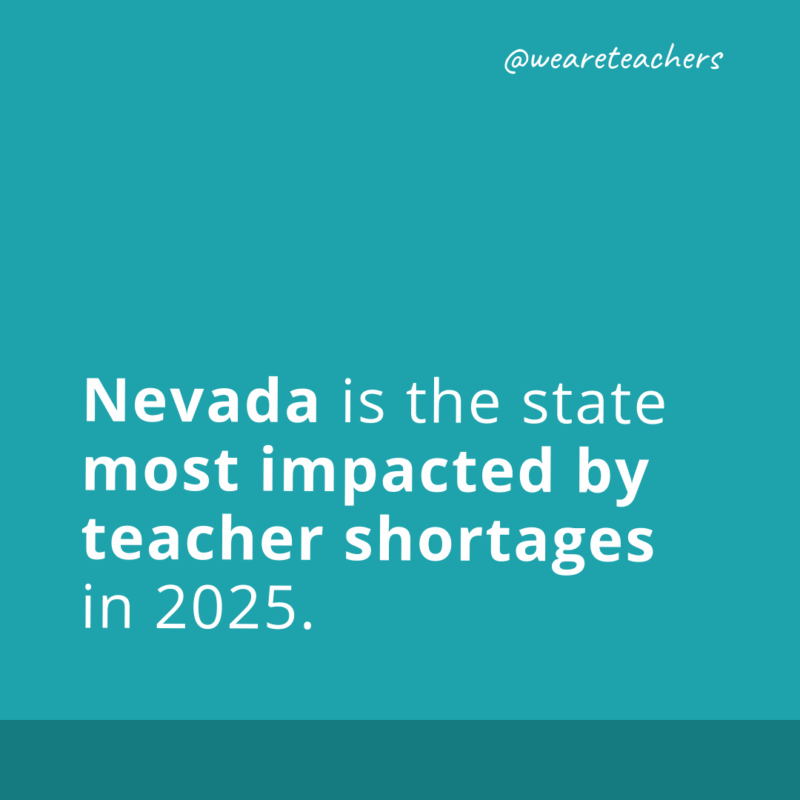
This takes into account not just the number of vacant teacher positions, but also rate of vacancies per 10,000 students. In Nevada, more than 1 in 10 teacher positions are vacant, and 16% of teachers are not qualified for the position they were hired for. The state currently has just 4.3 teachers for every 100 students.
Source: Fullmind
8. Utah, California, Florida, and Arizona are also heavily impacted by teacher shortages.
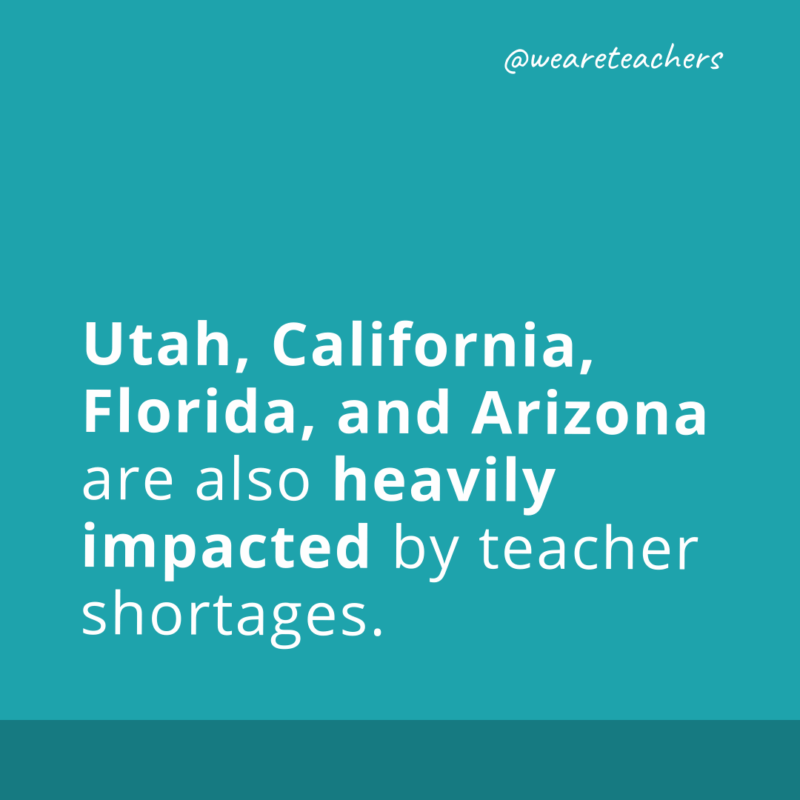
California has more than 10,000 unfilled teacher positions in 2025, and more than 32,000 positions filled by those who are not fully certified. In Florida, where teachers are among the lowest-paid in the nation, 4,400 teacher jobs are vacant. In Arizona, nearly 14% of teacher jobs are filled by those who are not fully certified for their teaching assignment. And while Utah has a fairly low number of vacancies, more than 10% of its jobs are filled by teachers not fully certified.
Source: Fullmind
9. Vermont, North Dakota, and Missouri are among the states least impacted by teacher shortages.
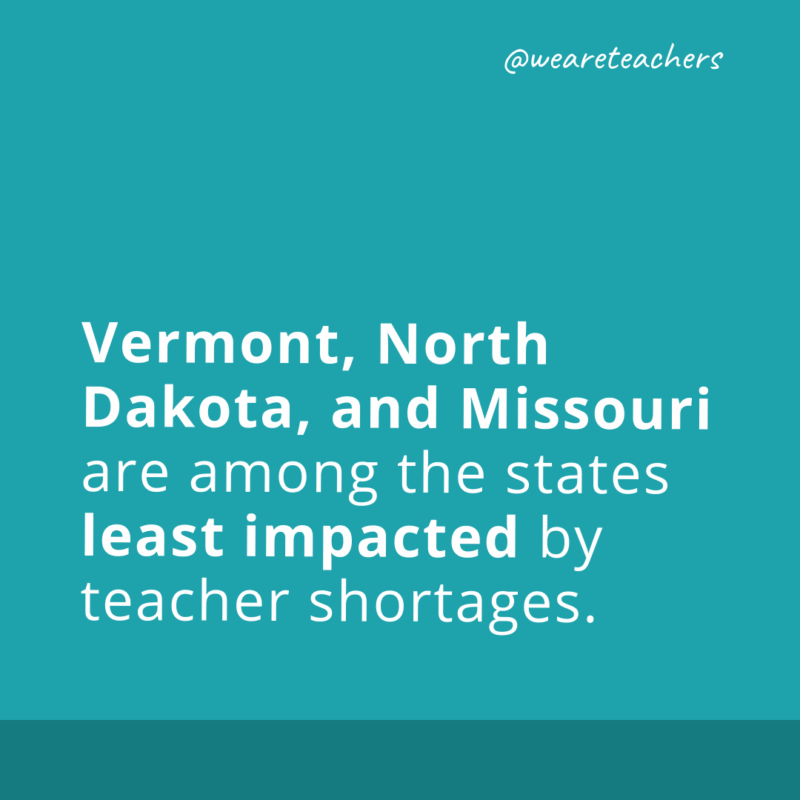
North Dakota reported just 200 teacher vacancies and only 74 teachers not fully qualified for their assignments. Vermont has a fairly low 400 vacant teacher positions, and more than 90% of their teachers are fully qualified for their positions. And in Missouri, just 1.2% of teacher positions are unfilled.
What is the number-one reason for teacher shortages?
10. Only 15% of educators are very satisfied with their pay.
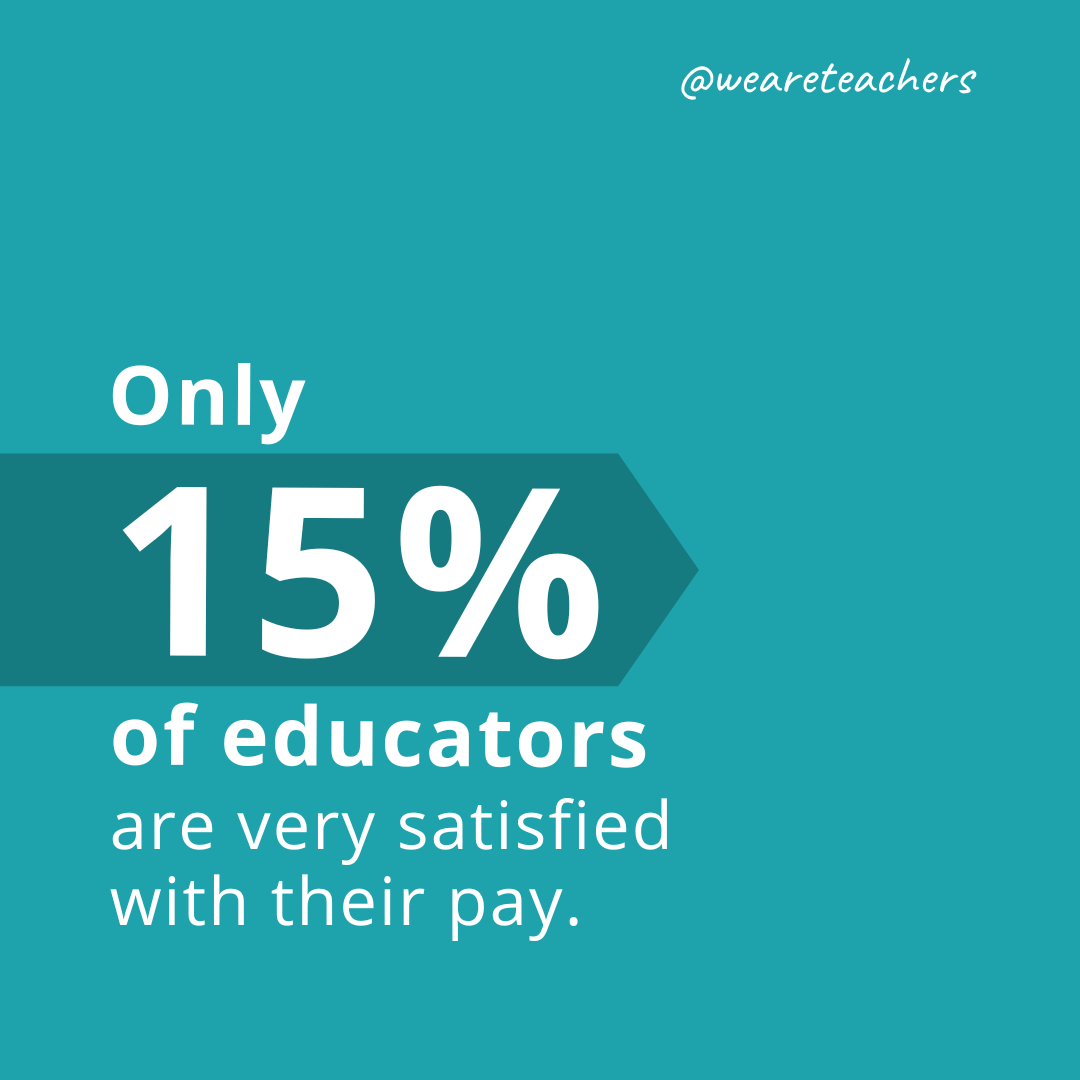
Can we pay teachers more? It’s no secret that teachers aren’t paid well. What’s interesting about teachers’ salaries, however, is that they vary across the country. And there are even some instances where teachers make less in certain states, but they’re required to do more after contract hours. We need uniformity around teacher salaries across the country, and we also need to value teachers’ time. Let’s give our teachers a wage that they can actually live on comfortably.
Source: Pew Research: What’s It Like To Be a Teacher in America Today?
11. Teachers make 5% less than they did 10 years ago.
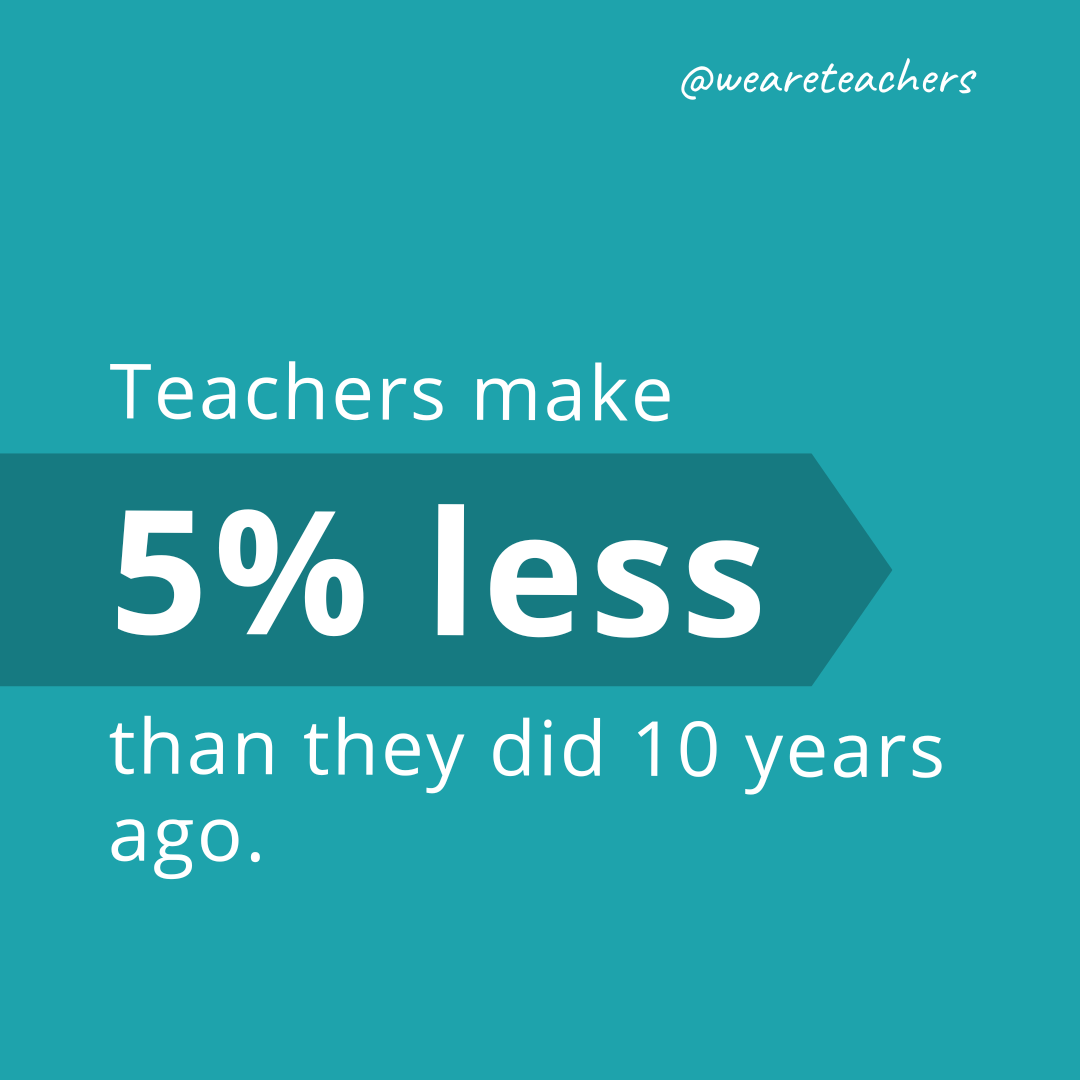
When you adjust for inflation, the average teacher salary has actually gone down over the years. The average starting teacher makes about $45,000 per year, which is considered by the Economic Policy Institute to be less than the minimum living wage in most areas. And nearly 30% of districts start teachers out at less than $40K. How can we end the teacher shortage if we’re not willing to pay them enough to make a basic living?
Source: NEA Educator Pay Data 2025
12. More than half of teachers (53%) say higher pay is the key to hiring a better and more diverse workforce.
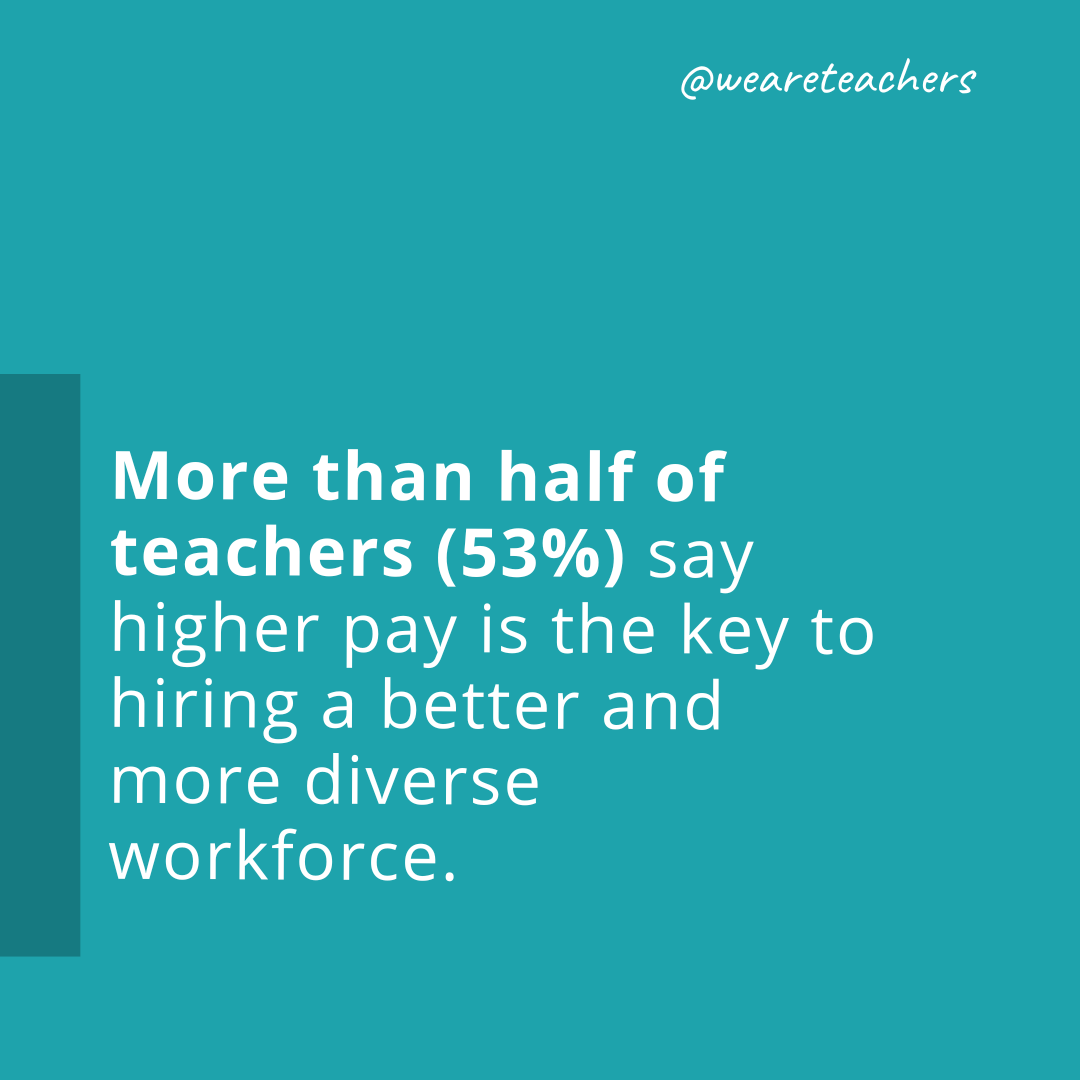
In case we’re not making the point clear, low pay is driving people away from the industry. Study after study and poll after poll have proven it: Teachers work hard and they deserve pay that reflects that. Twenty-one percent of teachers say that hard-to-staff districts should offer higher salaries. Look, we all know people don’t go into teaching to get rich. But that doesn’t mean they shouldn’t be rewarded for their efforts.
Source: Voices From the Classroom 2024
Why are so many US teachers quitting their jobs?
13. In K-12 education, 39% of teachers say they feel burned out “very often” or “always.”
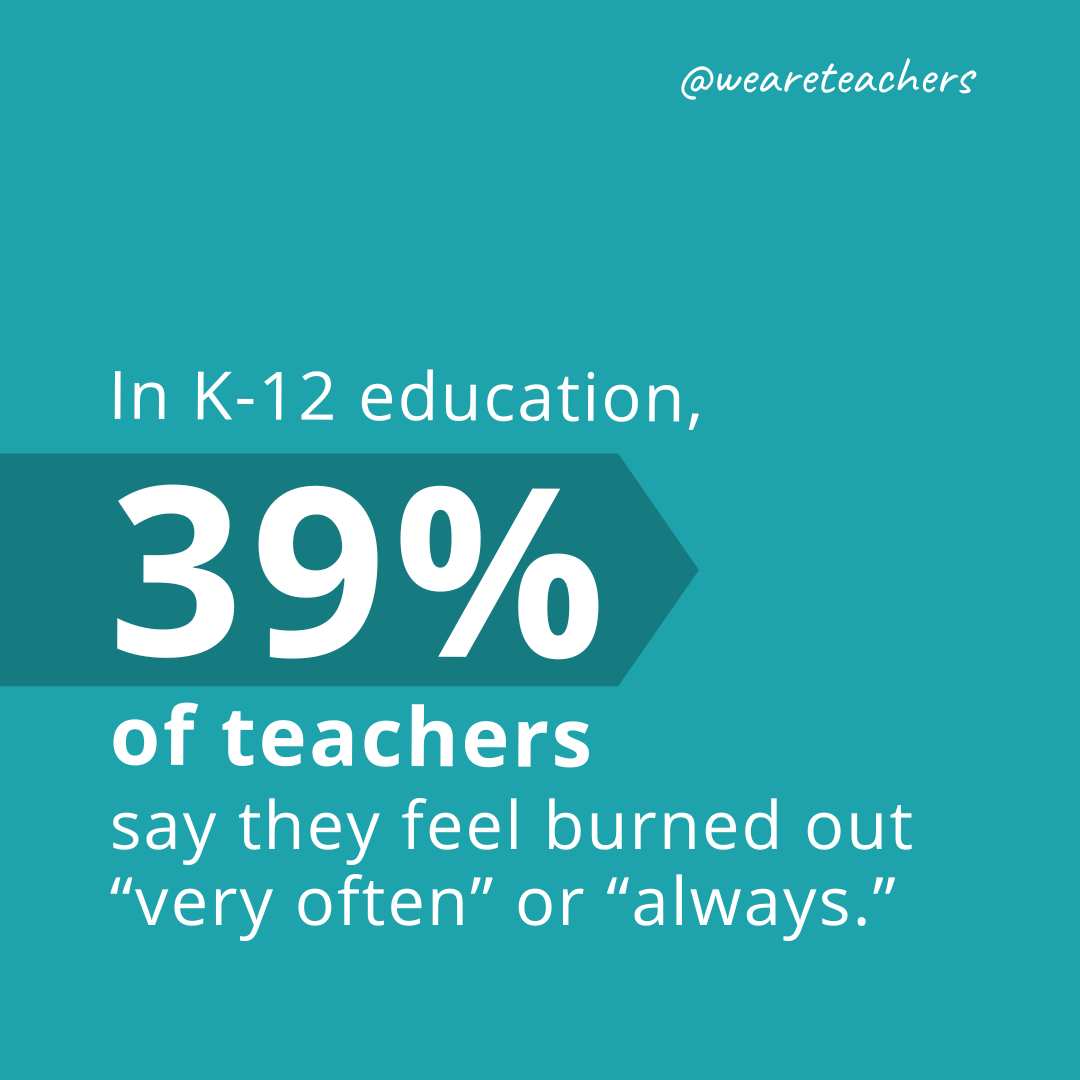
This is a slight improvement over last year, when 44% of teachers reported consistent burnout. But that still means that two out of every five teachers are feeling overwhelmed, exhausted, and at their wit’s end nearly every single day. Burnout is preventable though, and teachers have given us insight into what would make their work more sustainable (Hint: It’s salary, among other things).
Source: Gallup: The State of Schools Report 2024
14. More than three-quarters of teachers find their jobs stressful on a regular basis.
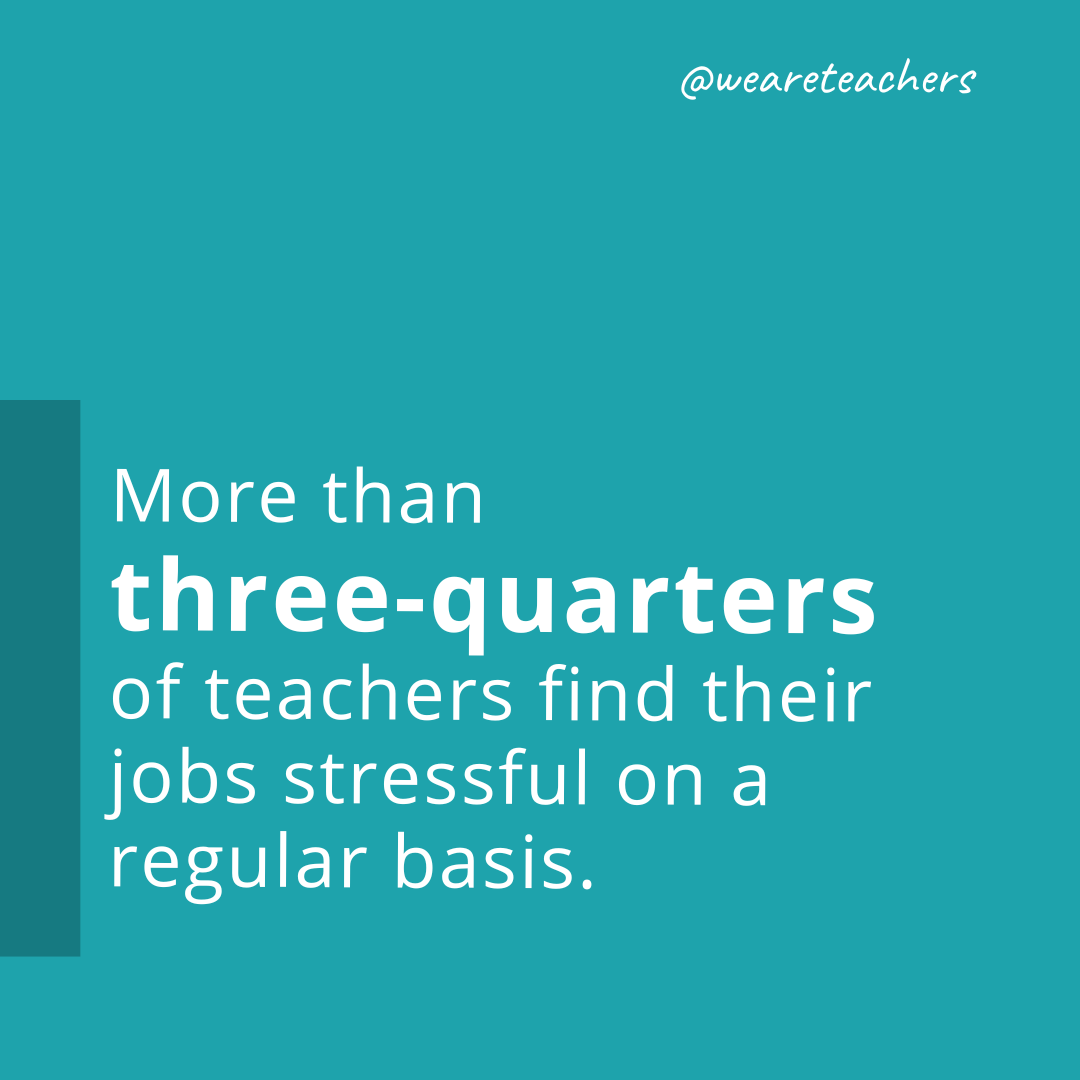
An overwhelming percentage of teachers say they are stressed (77%) and overwhelmed (68%) often or extremely often. In contrast, only 56% say their job is usually fulfilling, while 53% find it enjoyable most of the time. Teachers in general are very giving people, and they’re willing to do a lot for their students. But these levels of burnout are just not sustainable in the long run.
Source: Pew Research Center: How Teachers Manage Their Workload
15. Most teachers (82%) say public K-12 education has gotten worse over the last five years.
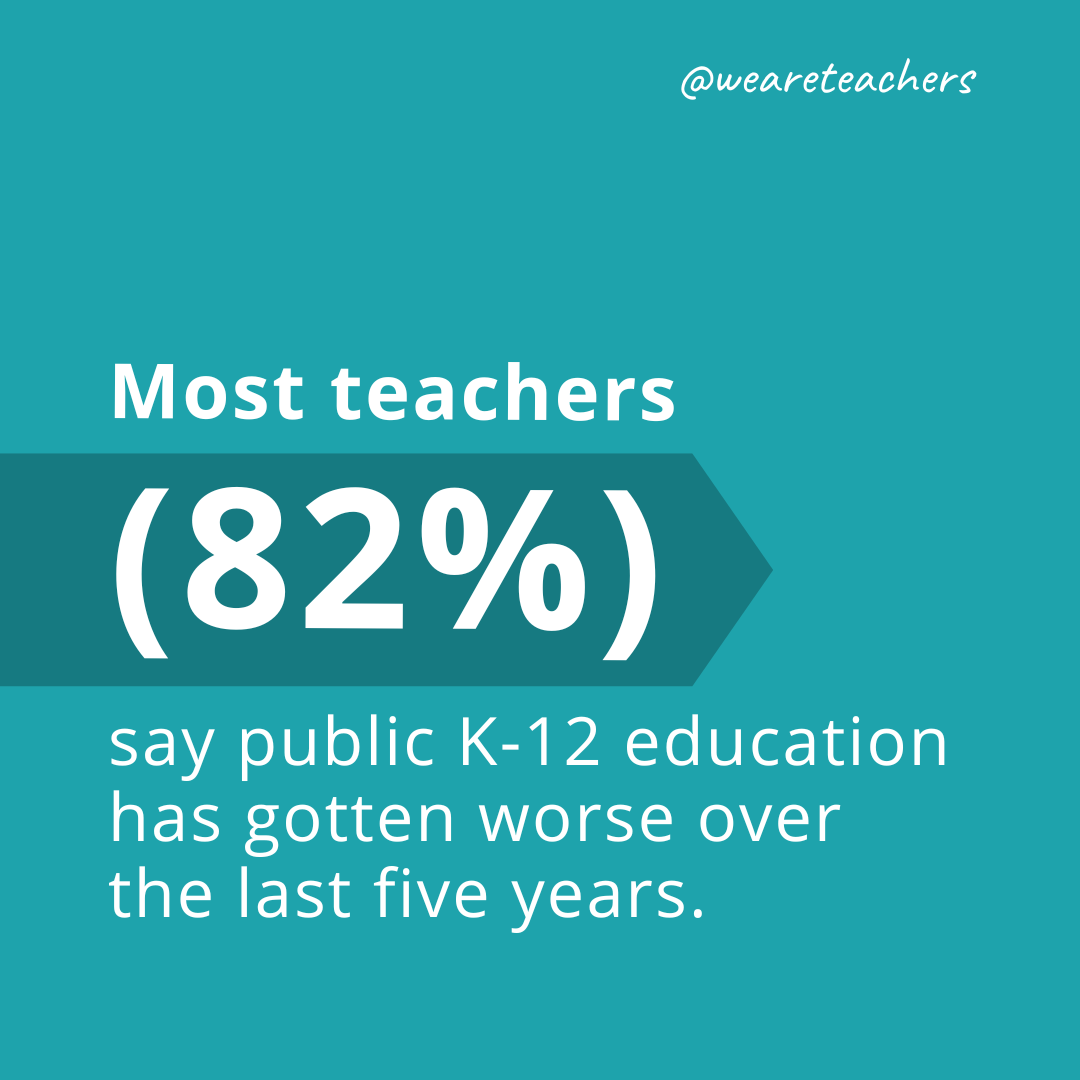
No one knows the state of education better than those on the front lines—and teachers are telling it like they see it. Sixty percent blame it on the current political climate, and 46% are disheartened by the lack of funding and resources available. An even more discouraging statistic? More than half of teachers expect things to get even worse over the next five years.
Source: Pew Research Center: Teachers’ Views on the State of Public K-12 Education
16. Teachers feel disrespected more than any other industry: 42% of teachers say they do not feel respected by the public.
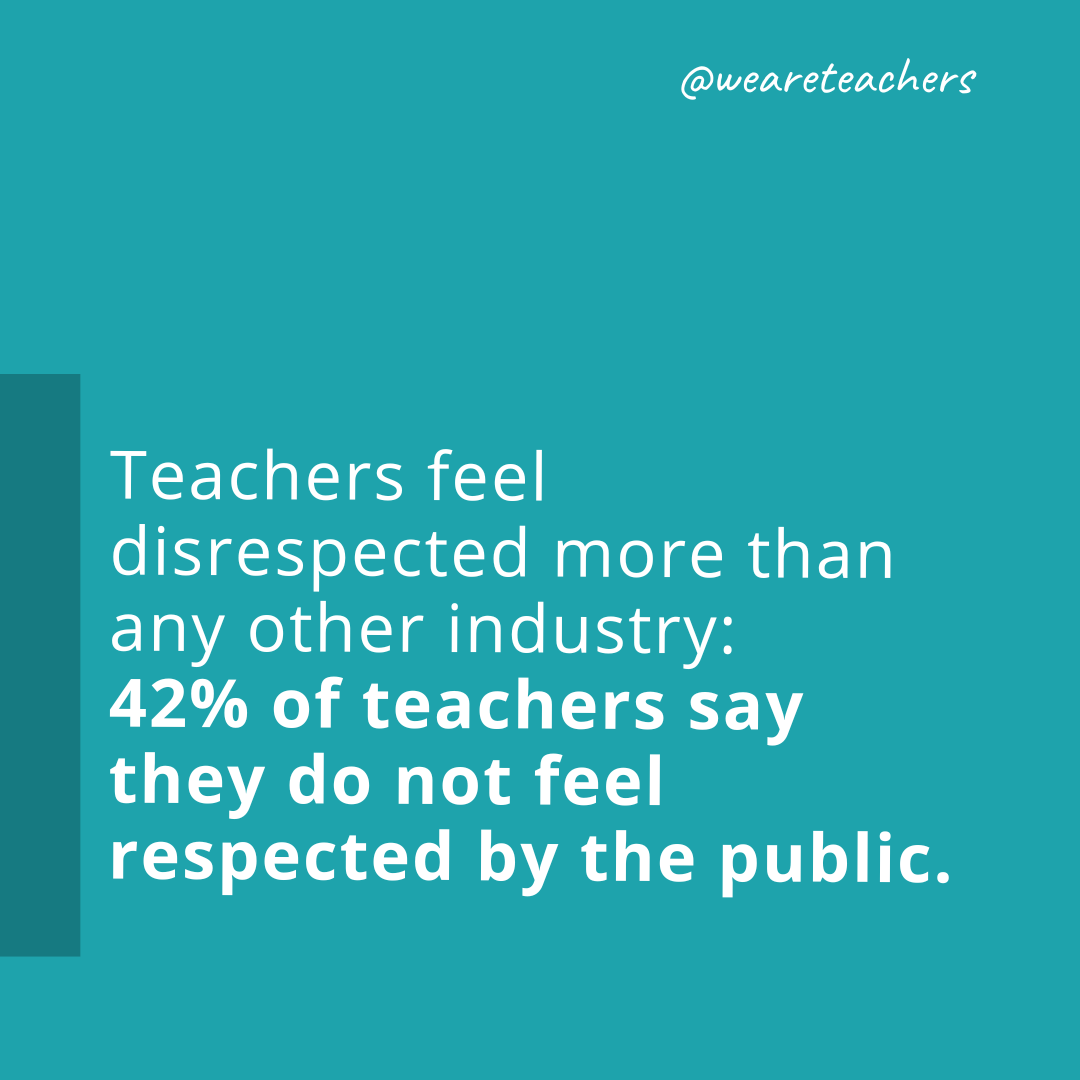
People assume that teachers have summers off to relax, when we’re actually busy with our second jobs. During the year, teachers deal with serious issues like books being banned, lessons being censored, and curriculum being dictated by parents and school boards. Helicopter parents email every day questioning our decisions. Even more alarmingly, 16% of teachers reported experiencing violence at their workplace in the last month. It’s no wonder teachers don’t feel respected. It’s time to listen to teachers and rely on their expertise.
Source: Gallup: The State of Schools Report 2024
What are some of the biggest challenges facing teachers today?
17. A staggering 94% of teachers spend their own money on basic classroom supplies.
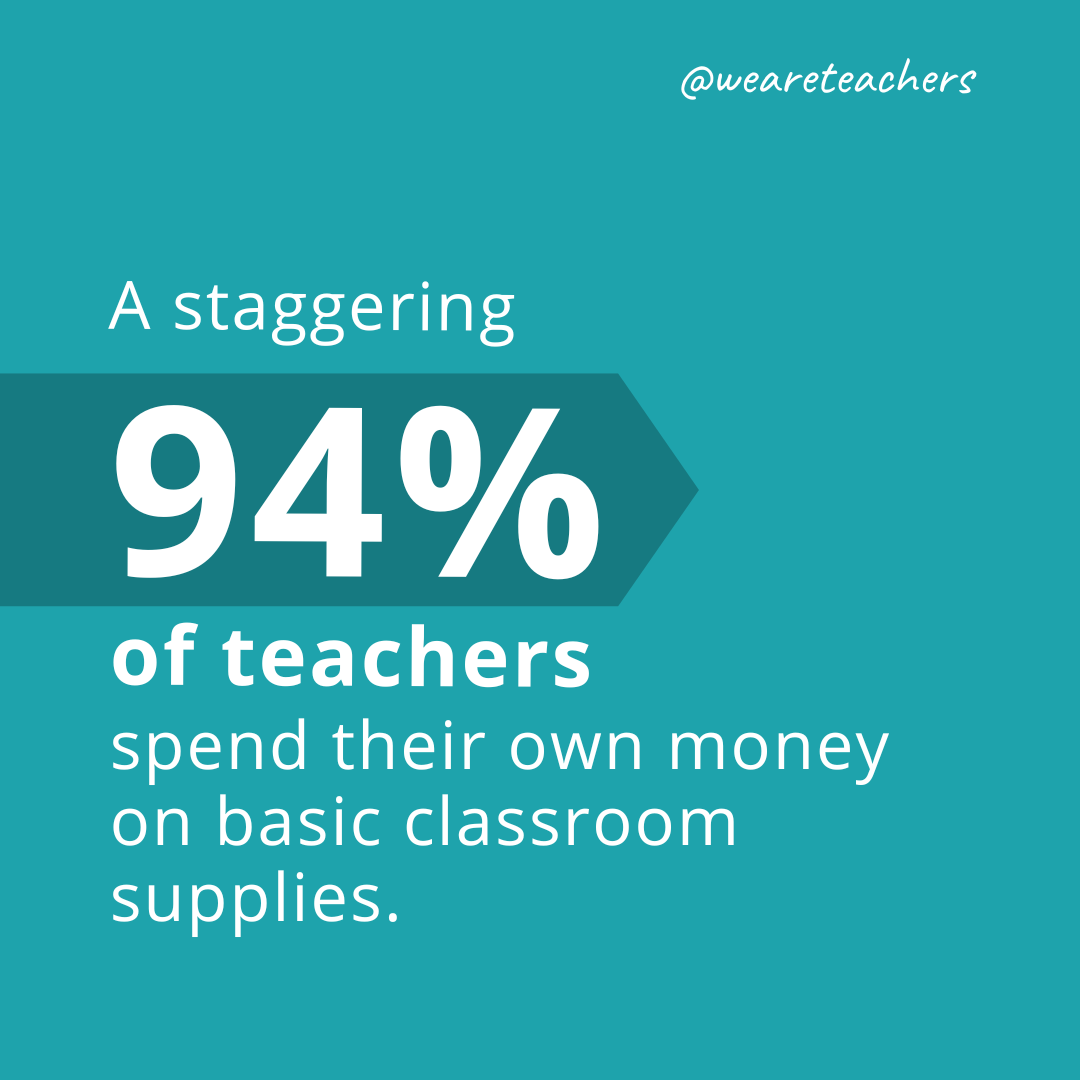
This is a story we’ve heard before. Educators are spending more and more of their own money on classroom supplies. And we’re not talking about just a little bit of money: The average is between $500 and $750 every single year. If lawyers and doctors aren’t buying their own legal pads and scalpels, why should we have to buy the basics?
Source: neaToday: Why Are Educators Still Buying Their Own School Supplies?
18. One in four teachers has been told to limit their classroom discussions on racism and underrepresented populations.
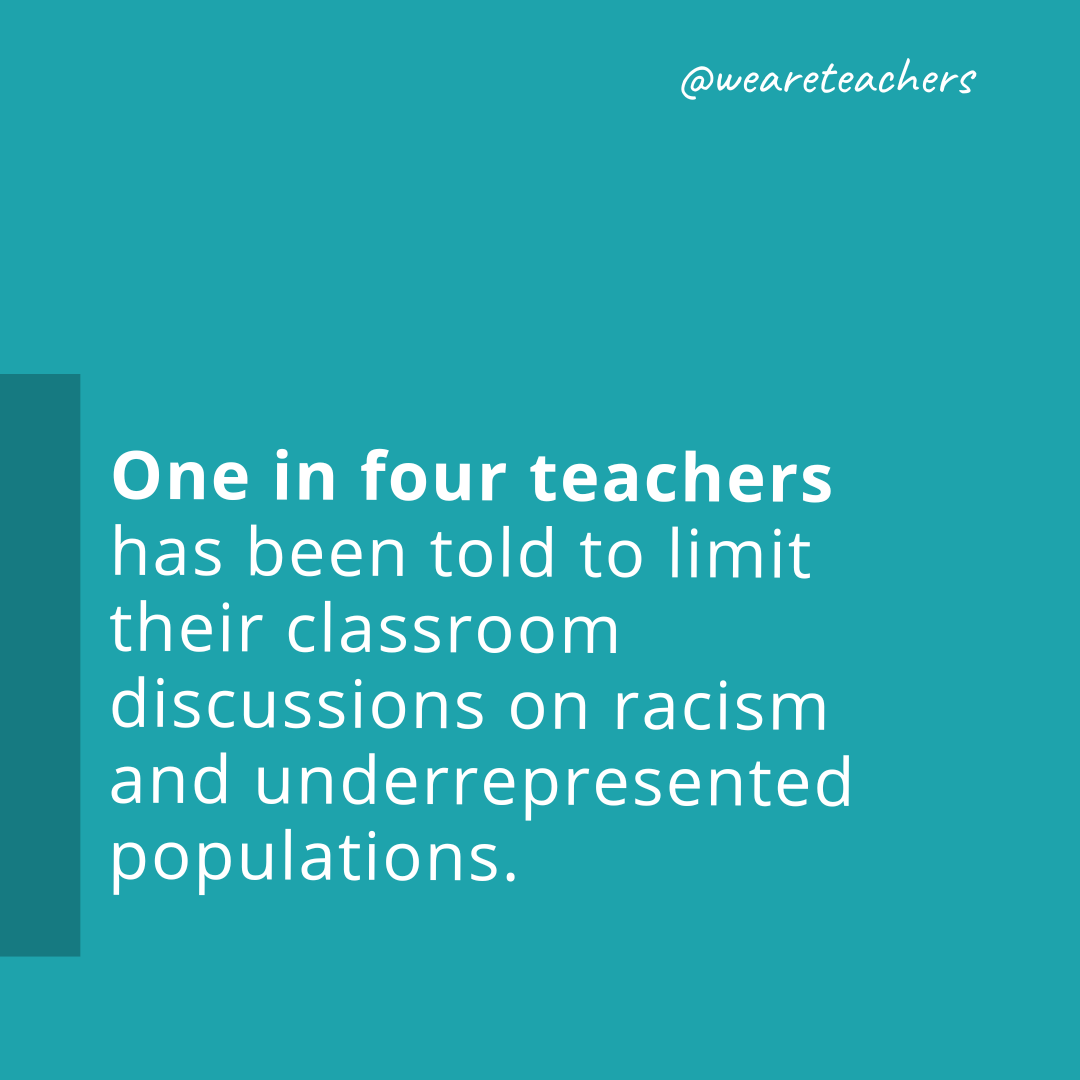
At a time when compassion and respect for diversity is more important than ever, teachers are incredibly frustrated by new limitations imposed by state and local districts. As schools ban more books and refuse to implement programs that acknowledge systemic racism and discrimination, teachers are getting more and more discouraged. This is not a smart way to recruit and keep strong talent in the field.
Source: Voices From the Classroom 2024
19. Most teachers (67%) want more say in their school’s disciplinary practices.
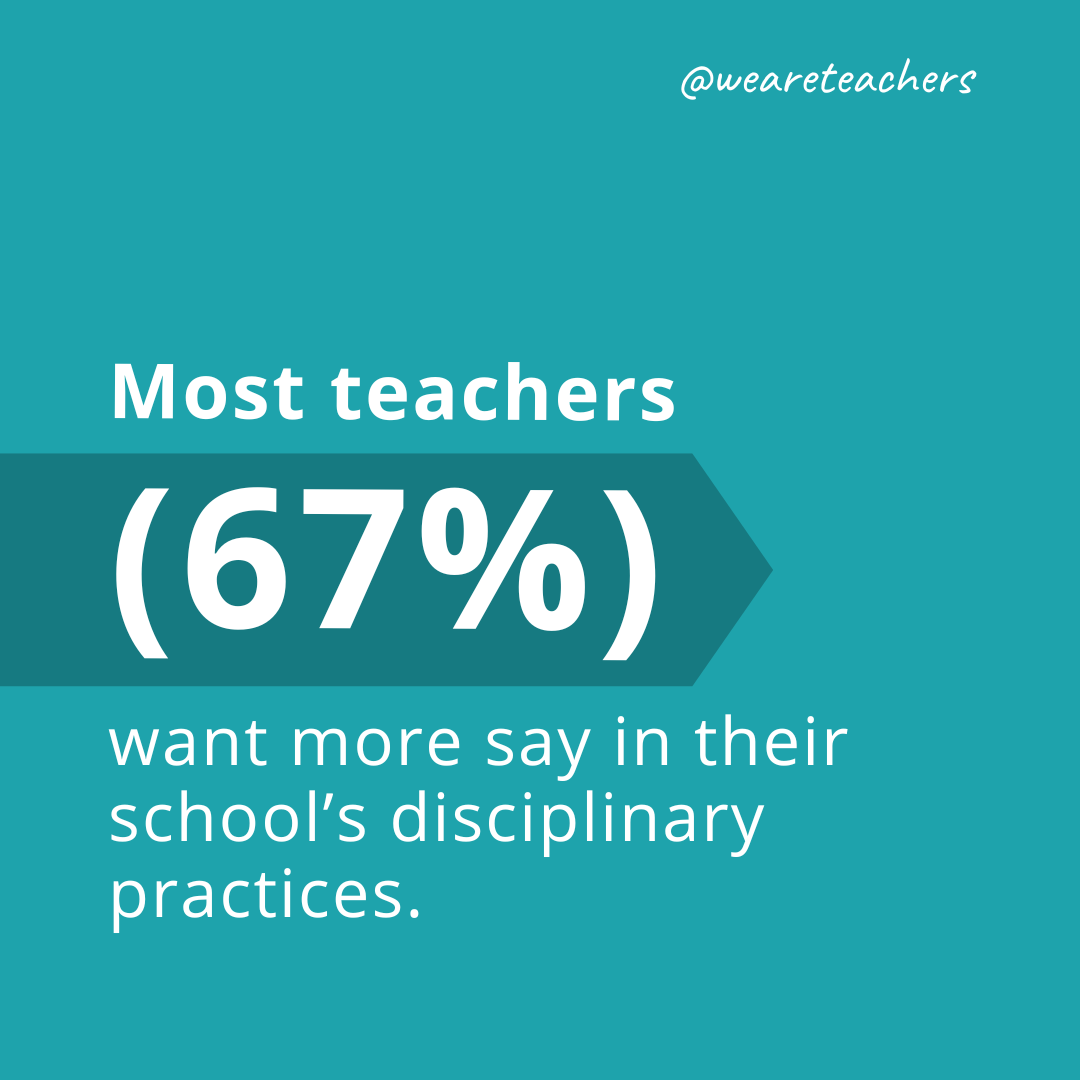
Interestingly, according to teacher shortage statistics, 31% of teachers also say that administrators don’t have enough influence in discipline practices. Who exactly is making the rules then? And who’s helping to enforce them? Too often, it’s not the parents: Nearly 80% of teachers say parents do too little to hold their kids accountable for their behavior at school. It’s hard to teach effectively when you’re spending all your time dealing with behavior issues, so it’s time for districts to come up with some new solutions.
Source: Pew Research Center: Problems Students Are Facing at Public K-12 Schools
20. 43% of public schools reported that school staffs’ concern about mental health issues has increased over the last year.
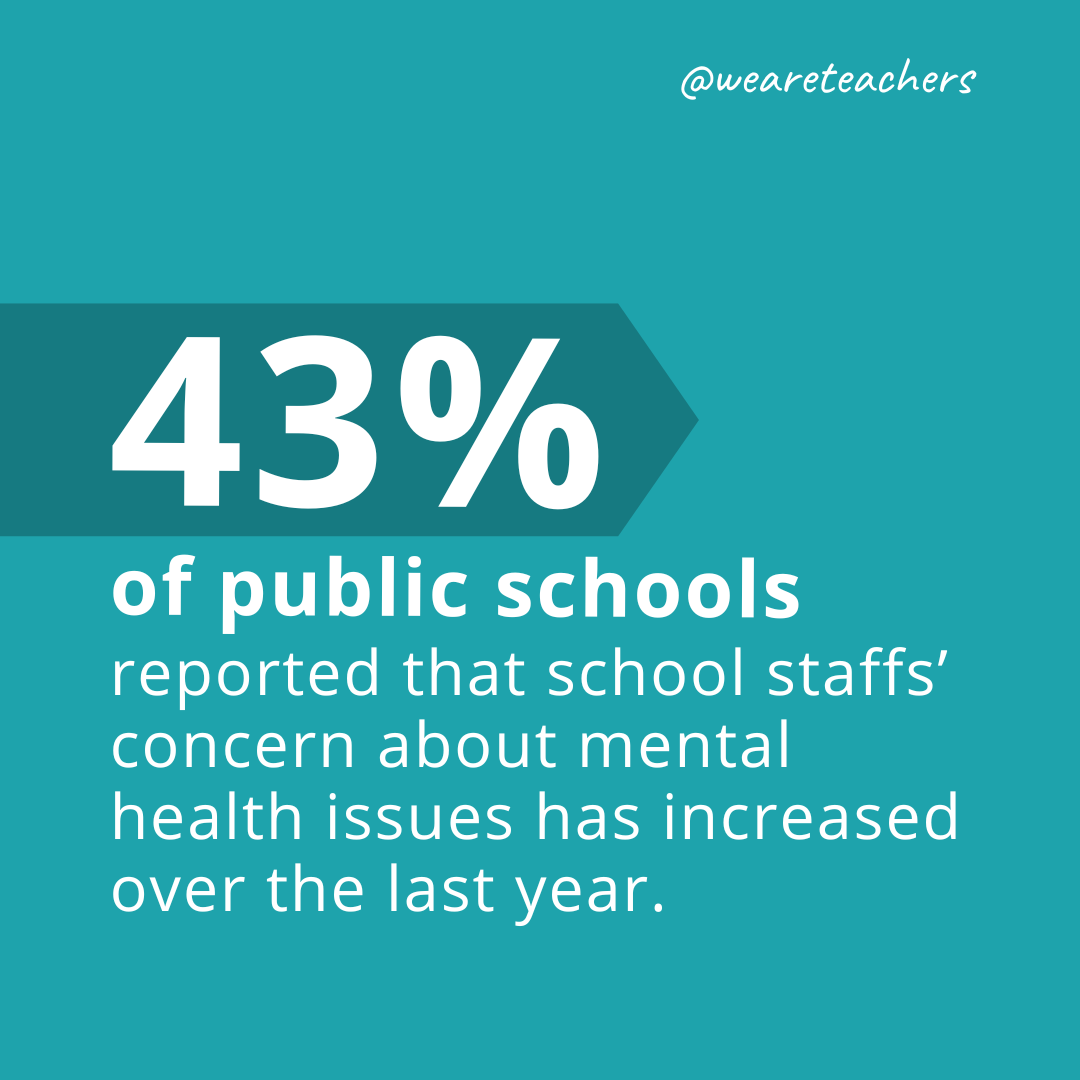
One poll of teacher shortage statistics noted that a huge chunk of school staff members are concerned about their own mental health or that of their colleagues. They’re seeing more signs of depression, anxiety, trauma, or emotional dysregulation/disturbance among their fellow educators. But only 35% of schools report using school funding for staff mental health support services, while only a little over half (59%) offer help through an employee assistance program (EAP). We’ve got to start supporting teachers’ mental health if we want them to stay in the classroom.
Source: School Pulse Panel March 2024
21. 84% of teachers say they have too much work to get done in an average workday.
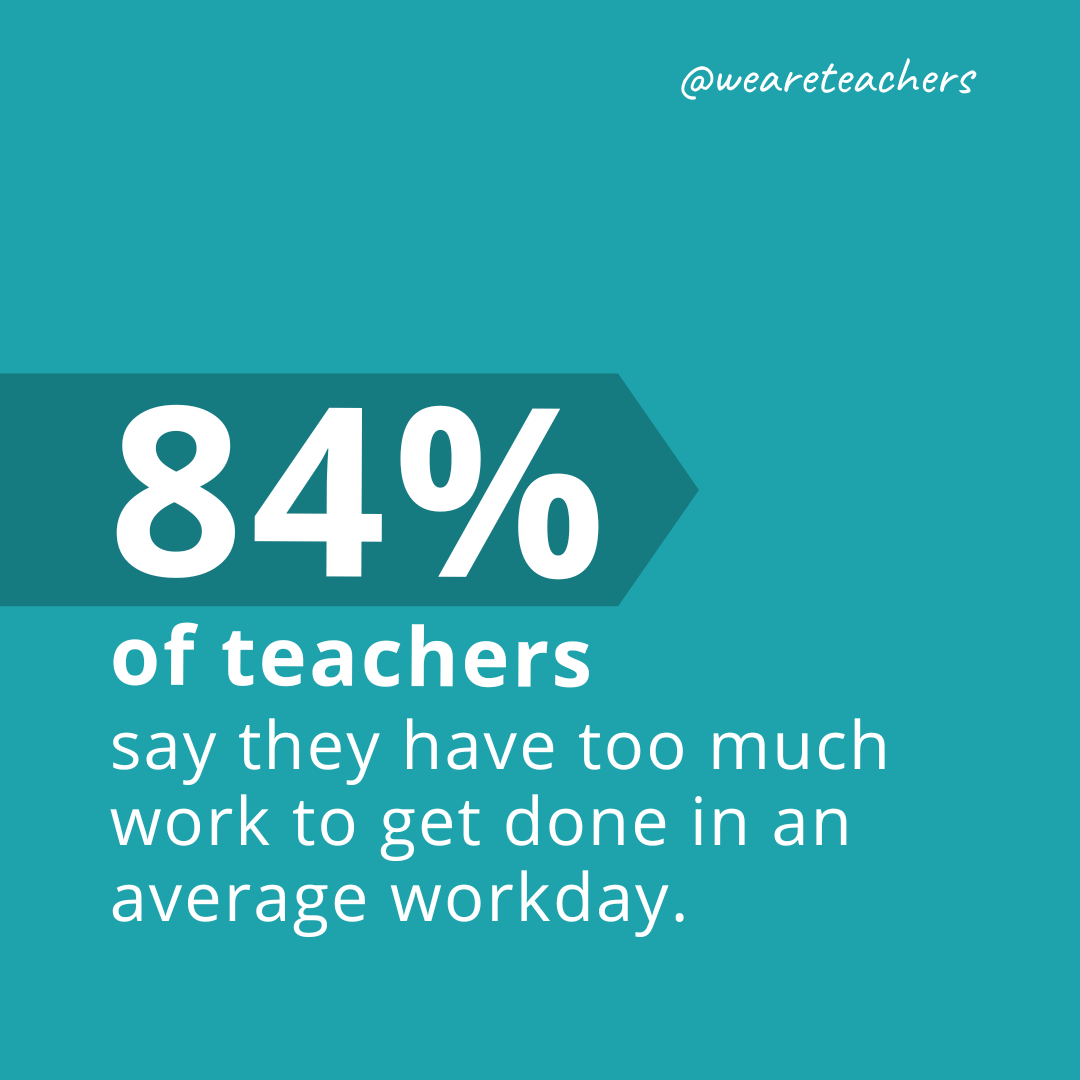
When asked about time management, 81% of teachers stated they “just have too much work” as a major reason they don’t work eight-hour days, and another 17% said it was a contributing factor. Most teachers (72%) also report spending too much time on non-teaching tasks like lunch or recess duties, and more than half often have to cover for other teachers’ classes. Add it all up, and it’s not surprising that 54% of teachers say it’s hard to achieve work-life balance.
Source: Pew Research Center: How Teachers Manage Their Workload
More Teacher Shortage Statistics
22. Most Americans (67%) believe that teaching is harder than most other jobs.
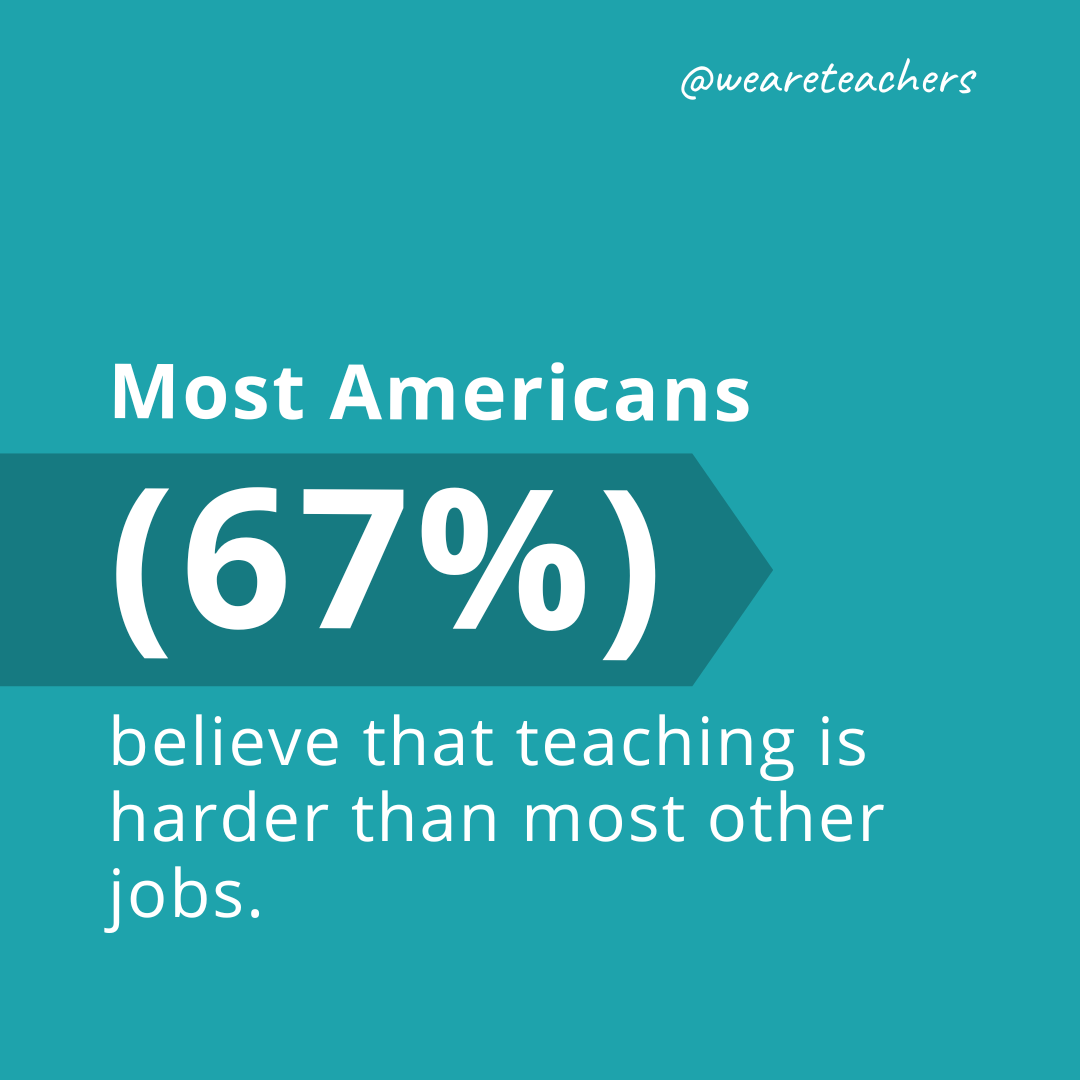
And what’s more, 74% of them think teachers need to be paid more, and nearly 40% of them think teachers should be paid a lot more! The general public gets it, but they aren’t necessarily willing to spend their own tax dollars to make it happen. For instance, in March 2024, 36 Ohio school districts had levies on the ballot to increase school taxes. Only six of those were passed. And 17 of 57 district levies to sustain existing school funding were turned down.
Source: Pew Research Center: What Teachers Want Americans To Know About Teaching
23. Only 16% of educators would strongly recommend the profession to others.

Teachers are so unhappy that they wouldn’t recommend teaching as a profession. Only 30% of them consider it rewarding, and just 19% think it’s a sustainable career choice. Most teachers say that low pay, heavy workload, and difficulty maintaining a work-life balance are to blame. The number-one thing most of them want? More money for more work. Sounds fair to us.
Source: Voices From the Classroom 2024
24. Only 29% of BIPOC teachers said they were very likely to stay in the classroom for their entire career.
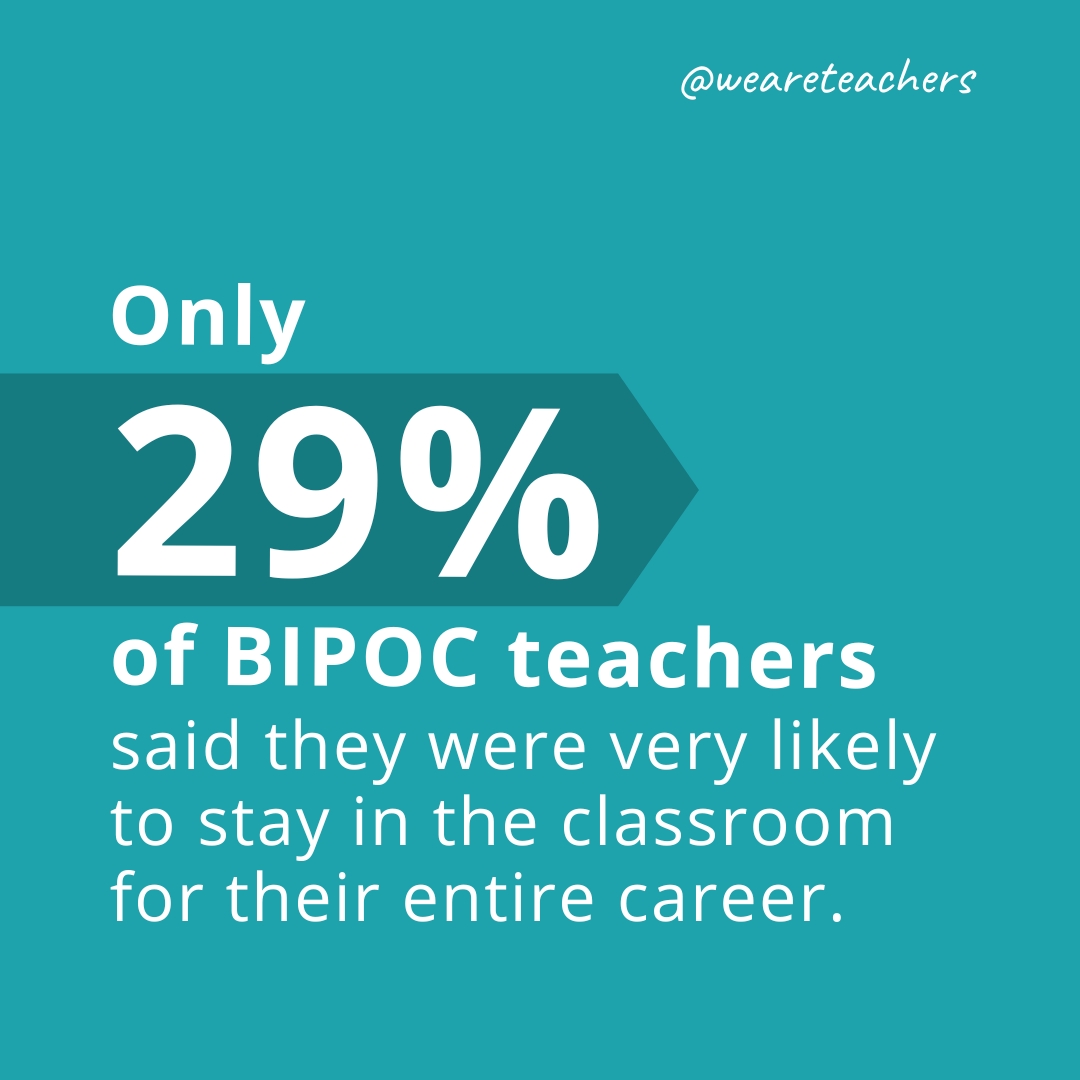
This is one of the most concerning teacher shortage statistics because we need BIPOC teachers. A diverse teaching workforce is good for teachers as well as students. Plus, in general, BIPOC teachers have a more positive view of the job and feel they make a bigger impact overall on their students. But nearly 80% of them feel that the one-size-fits-all version of public education doesn’t meet their students’ academic needs. We need to keep giving these teachers the resources and flexibility they need to reach their communities successfully.
Source: Voices From the Classroom 2024
25. Teachers experience less job satisfaction than other professions: Only 33% say they’re “very satisfied” with their jobs.
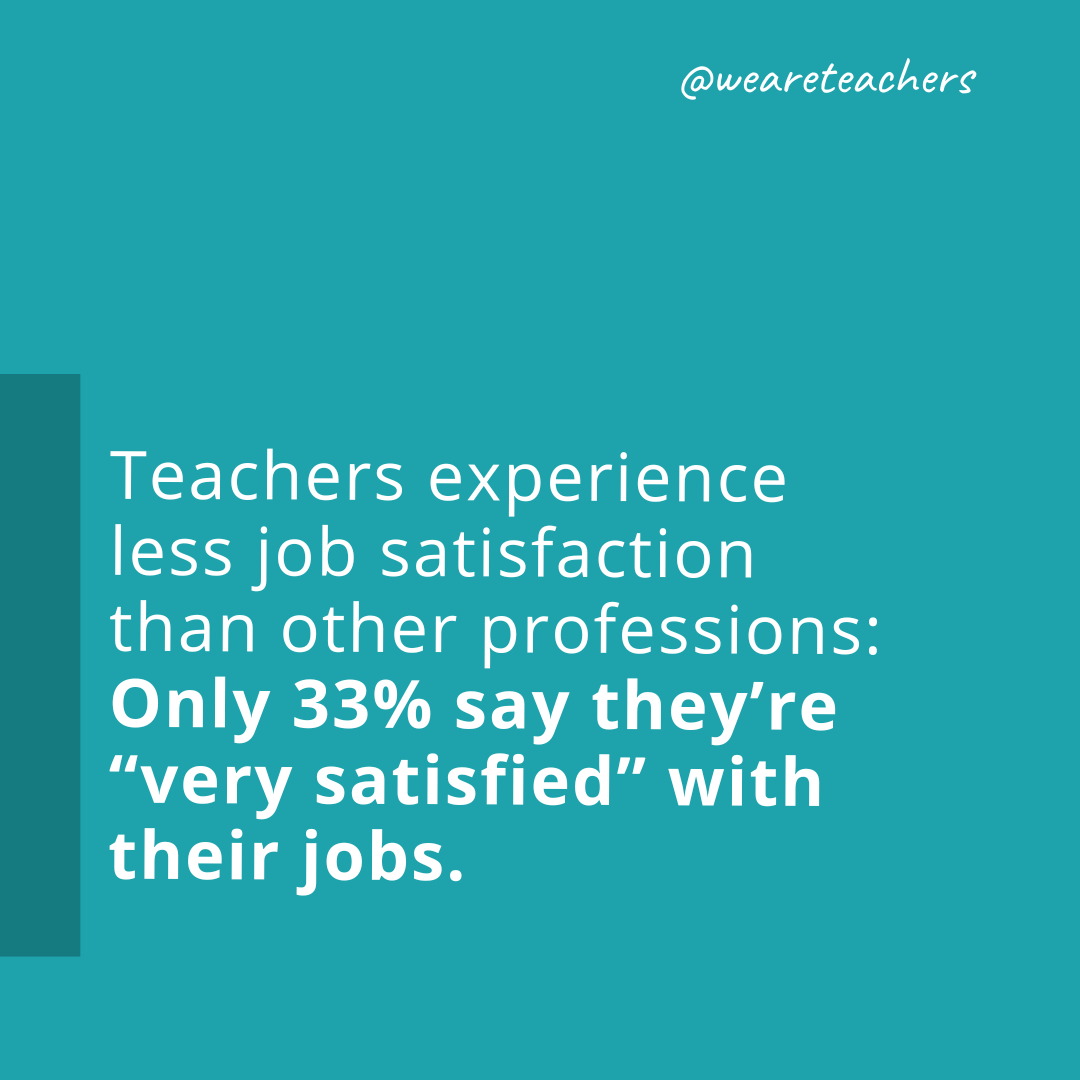
Overall, over half of US workers consider themselves “very satisfied” with their jobs, compared with only a third of teachers. And 18% of teachers say they are not at all satisfied with their jobs, compared with just 12% of those in other professions.
Still, more than 80% of teachers say they’re at least somewhat satisfied with their job, which is up dramatically from previous years. In 2023, only 20% of teachers reported feeling “very satisfied” with their jobs, so we’re making some strides in this area. How do we keep the momentum going?
One answer may already be in the school building: strong leadership. According to U.S. News & World Report, teachers who have felt supported by their school administration want to stay. Teachers are also staying if they feel they have a voice and are being heard in the decision-making process.
Source: Pew Research Center: Teachers’ Job Satisfaction
Get your free printable How To Become a Teacher poster:

We’ve made it easy to share the steps toward becoming a teacher. Grab this free printable poster and help change these teacher shortage statistics for the better.








Recent Comments